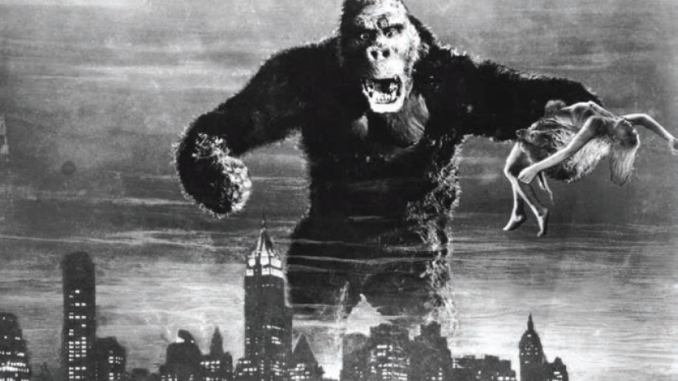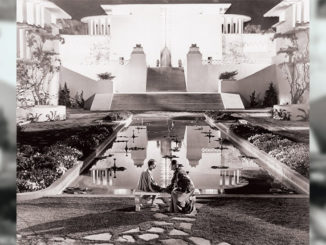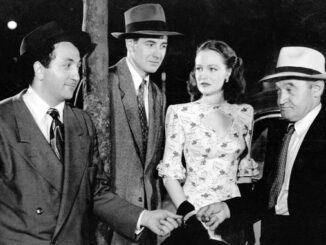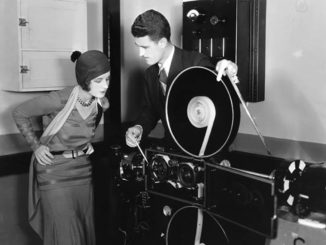
By Kevin McMahon
I f you were a boy in the 1950s, growing up in the New Jersey suburbs, and your middle-class family possessed a TV set — a tiny, murky B&W screen like a submarine porthole inside an enormous cabinet with control dials you’d have to actually get up off the sofa to adjust; in other words, if you were me — you had access to about half a dozen television stations. One of these was WOR-Channel 9, whose stock in trade was old movies. The jewel in the crown of their broadcast week, at least as far as I was concerned, was “The Million Dollar Movie,” which aired twice a day, Monday through Saturday.
When I wasn’t outside with the neighborhood gang playing stickball, shooting marbles, jumping into leaf piles, and building mud forts in the woods (yes, we did this stuff), I was on the lounger in our den, glued to the TV. I watched everything, whatever they had, but my absolute favorite, the one movie I would never and could never miss, was “King Kong.” Those three massive descending chords at the start of Max Steiner’s score heralded entry into a kingdom of fantastic adventure and strangeness. This was my first introduction to the real primal magic of the movies. Even all these years later, and despite all the reboots, remakes, spinoffs, and pop culture ephemera depicting every conceivable variation of the giant monkey atop the Empire State Building with the blonde in his paw, the 1933 production in its original form continues to exert its inexorable grip on the imagination.
After the wonderfully corny fake Arab proverb about “Beauty and the Beast” on a title card that announces the movie’s theme right up front… FADE IN: The wharves of Manhattan on a foggy night. A tugboat crosses mid-screen, foreshadowing a passage over water to a mystery-wrapped island. There’s a sense of hushed anticipation, for what we don’t yet know.
In a last-minute search for an ingenue to add “love interest” to his latest quasi-documentary jungle epic, Robert Armstrong’s freebooting producer scoops Depression waif Fay Wray off the mean streets. When she faints from hunger into his arms and he gets a good look at her face, lit in closeup by a pristine, sensual inner glow of ardent vulnerability — and even as a pre-adolescent boy impatient to get past the setup and into the action, I knew Fay Wray was a real dish — Armstrong reacts: “Hey! Taxi!”
The ensuing voyage via tramp steamer develops the characters and kindles an onboard romance for Wray with the rough-hewn first mate played by Bruce Cabot. Cabot here embodies the dualism of the Hollywood man of action as romantic hero, transitioning from gruff dismissal of the woman as “a nuisance” to befuddled infatuation: “Say…I guess I love you.” Once the company reaches Skull Island and plunges into the heart of its dark secret, the action never lets up. You all know the story, or you should. Giant Gorilla Meets Girl, Giant Gorilla Loses Girl, Giant Gorilla Gets Girl. Then, overcome by his (completely understandable) obsession with Wray, Kong meets his tragic end: “’Twas Beauty killed the Beast.”
Years after I first fell under the movie’s spell, I visited the LA home of Forrest J Ackerman, the presiding genius of the ‘50s fan mag, “Famous Monsters of Filmland,” the bible for horror-obsessed youth. Forry’s house was crammed with the memorabilia he’d collected over a lifetime in the business.
Among the most cherished items on display was one of the original articulated metal models for Kong. About a foot and a half tall, rust-flecked and dotted with the tattered remnants of its rabbit fur cladding, it was a singularly unimpressive object — that is, until you recalled the impact it had in its prime, re-positioned one frame at a time by the movie’s ingenious craftsmen to create the illusion of the giant gorilla on his romantic rampage across Skull and Manhattan islands.
Here, truly, was the stuff that dreams are made of.
Kevin McMahon worked around town over the years as journalist, publicist, Moviola repairman, screenwriter, development executive and script reader, before retiring as a senior story analyst at WB Pictures. He’s reachable at kmcmahon50@gmail.com.





